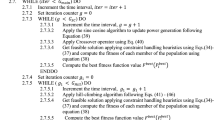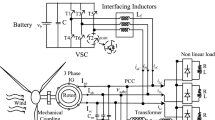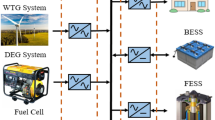Abstract
A differential evolution (DE) tuned tilt integral derivative controller with filter (TIDF) has been implemented to a multi area reheat thermal power system for automatic generation control by taking the physical constraints like generation rate constraint and governor dead band nonlinearity. Initially, dissimilar integral controllers are considered in each area and the integral controller gains have been optimized by integral of time multiplied by absolute value of error (ITAE) criterion exploiting different strategies of DE algorithm. In next step, the control parameters such as step size and crossover probability of DE for the best strategy can be chosen with multiple iterations of the algorithm systematically for variation in each control parameter and DE proposes the control parameters. Further, PI/PID/TIDF type controller schemes have been modified and their gains have been optimized by optimal DE. Furthermore, to improve the transient system response, TIDF controller coordinated unified power flow controller (UPFC) has been investigated. The simulation results reveal that the minimum ITAE value is obtained when UPFC is placed in area-5 only. Finally, sensitivity analysis has been done by changing the operating load conditions along with the time constants of system parameters, from the simulation results it has been examined that there is no need to reset the controller parameters from their nominal setting for these variations. The proposed control scheme effectiveness is also observed by considering random step load disturbance and sinusoidal load disturbance.











Similar content being viewed by others
References
Elgerd OI (2007) Electric energy systems theory. An introduction, 2nd edn. Tata McGraw-Hill, New Delhi
Kundur P (1994) Power system stability and control. McGraw-Hill, New York
Bevrani H (2009) Robust power system frequency control. Springer, New York
Bevrani H, Hiyama T (2011) Intelligent automatic generation control. CRC Press, Boca Raton
Dhiman G, Kumar V (2017) Spotted hyena optimizer: a novel bio-inspired based metaheuristic technique for engineering applications. Adv Eng Softw 114:48–70
Dhiman G, Kumar V (2018) Multi-objective spotted hyena optimizer: a multi-objective optimization algorithm for engineering problems. Knowl Based Syst 150:175–197
Dhiman G, Kaur A (2017) Spotted hyena optimizer for solving engineering design problems. In: Machine learning and data science (MLDS), international conference on, IEEE, pp 114–119
Dhiman G, Kaur A (2018) Optimizing the design of airfoil and optical buffer problems using spotted hyena optimizer. Designs 2(3):28
Dhiman G, Kumar V (2019) Spotted hyena optimizer for solving complex and non-linear constrained engineering problems. In: Yadav N, Yadav A, Bansal JC, Deep K, Kim JH (eds) Harmony search and nature inspired optimization algorithms. Springer, Singapore, pp 857–867
Chandrawat RK, Kumar R, Garg BP, Dhiman G, Kumar S (2017) An analysis of modeling and optimization production cost through fuzzy linear programming problem with symmetric and right angle triangular fuzzy number. In: Proceedings of sixth international conference on soft computing for problem solving. Springer, Singapore, pp 197–211
Singh P, Dhiman G (2018) A hybrid fuzzy time series forecasting model based on granular computing and bio-inspired optimization approaches. J Comput Sci 27:370–385
Dhiman G, Kumar V (2018) Emperor penguin optimizer: a bio-inspired algorithm for engineering problems. Knowl Based Syst 159:20–50
Kaur A, Dhiman G (2019) A review on search-based tools and techniques to identify bad code smells in object-oriented systems. In: Yadav N, Yadav A, Bansal JC, Deep K, Kim JH (eds) Harmony search and nature inspired optimization algorithms. Springer, Singapore, pp 909–921
Singh P, Dhiman G (2018) Uncertainty representation using fuzzy-entropy approach: special application in remotely sensed high resolution satellite images (RSHRSIs). Appl Soft Comput 72:121–139
Singh P, Dhiman G, Kaur A (2018) A quantum approach for time series data based on graph and Schrödinger equations methods. Mod Phys Lett A 33(35):1850208
Dhiman G, Kumar V (2018) Astrophysics inspired multi-objective approach for automatic clustering and feature selection in real-life environment. Mod Phys Lett B 32(31):1850385
Dhiman G, Kaur A (2019) A hybrid algorithm based on particle swarm and spotted hyena optimizer for global optimization. Soft computing for problem solving. Springer, Singapore, pp 599–615
Shayeghi H, Shayanfar HA, Jalili A (2009) Load frequency control strategies: a state-of-the art survey for the researcher. Int J Energy Convers Manag 50(2):344–353
Elgerd OI, Fosha C (1970) Optimum megawatt-frequency control of multiarea electric energy systems. IEEE Trans Power Appar Syst 89(4):556–563
Fosha C, Elgerd OI (1970) The megawatt-frequency control problem: a new approach via optimal control. IEEE Trans Power Appar Syst 89(4):563–577
Calovic MS (1972) Linear regulator design for a load and frequency control. IEEE Transactions on Power Apparatus Systems 91(6):2271–2285
Ali ES, Abd-Elazim SM (2013) BFOA based design of PID controller for two area load frequency control with nonlinearities. Int J Electr Power Energy Syst 51:224–231
Sahu RK, Panda S, Padhan S (2014) Optimal gravitational search algorithm for automatic generation control of interconnected power systems. Ain Shams Eng J 5(3):721–733
Gozde H, Taplamacioglu MC, Kocaarslan I (2012) Comparative performance analysis of Artificial Bee Colony algorithm in automatic generation control for interconnected reheat thermal power system. Int J Electr Power Energy Syst 42(1):167–178
Sahu RK, Sekhar C, GT., and Panda S (2016) Automatic generation control of multi-area power systems with diverse energy sources using teaching learning based optimization algorithm. Eng Sci Technol Int J 19(1):113–134
Chandra Sekhar GT, Sahu RK, Panda S (2015) Comparative performance analysis of classical controllers in LFC using FA technique. In: IEEE international conference on electrical, electronics, signals, communication and optimization (EESCO)
Khuntia SR, Panda S (2012) Simulation study for automatic generation control of a multi-area power system by ANFIS approach. Appl Soft Comput 12(1):333–341
Rout UK, Sahu RK, Panda S (2013) Design and analysis of differential evolution algorithm based automatic generation control for interconnected power system. Ain Shams Eng J 4(3):409–421
Saikia LC, Nanda J, Mishra S (2011) Performance comparison of several classical controllers in AGC for multi-area interconnected thermal system. Int J Electr Power Energy Syst 33(3):394–401
Sharma G, Nasiruddin I, Niazi KR, Bansal RC. Optimal (2016) AGC of a multi-area power system with parallel AC/DC tie lines using output vector feedback control strategy. Int J Electr Power Energy Syst 81:22–31
Guha D, Roy PK, Banerjee S (2016) Load frequency control of interconnected power system using grey wolf optimization. Swarm Evol Comput 27:97–115
Hingorani NG, Gyugyi L (2000) Understanding facts: concepts and technology of flexible AC transmission systems. IEEE Press, New York
Song YH, Johns AT, Flexible AC (1999) Transmission systems (FACTS). Institution of Electrical Engineers, London
Pradhan PC, Sahu RK, Panda S (2016) Firefly algorithm optimized fuzzy PID controller for AGC of multi-area multi-source power systems with UPFC and SMES. Eng Sci Technol Int J 19:338–354
Stron R, Price RK (1995) Differential evolution—a simple and efficient adaptive scheme for global optimization over continuous spaces. J Glob Optim 11:341–359
Das S, Suganthan PN (2011) Differential evolution: a survey of the state-of-the-art. IEEE Trans Evol Comput 15:4–31
Sahu RK, Panda S, Chandra Sekhar GT (2015) A novel hybrid PSO-PS optimized fuzzy PI controller for AGC in multi area interconnected power systems. Int J Electr Power Energy Syst 64:880–893
Chandra Sekhar GT, Sahu RK, Baliarsingh AK, Panda S (2016) Load frequency control of power system under deregulated environment using optimal firefly algorithm Int. J Electr Power Energy Syst 74:195–211
Chaudhuri B, Pal BC, Zolotas AC, Jaimoukha IM, Green TC (2003) Mixed-sensitivity approach to H ∞ control of power system oscillations employing multiple FACTS devices. IEEE Trans Power Syst 18(3):1149–1156
Chandrakala V, Sukumar B, Sankaranarayanan K (2014) Load frequency control of multi-source multi-area hydro thermal system using flexible alternating current transmission system devices. Electr Power Compon Syst 42(9):927–934
Sahu RK, Chandra Sekhar GT, Panda S (2015) A hybrid DE–PS algorithm for load frequency control under deregulated power system with UPFC and RFB. Ain Shams Eng J 6(3):893–911
Lurie BJ (1994) Three-parameter tunable tilt-integral-derivative (TID) controller. US Patent, US5371670
Sahu RK, Panda S, Biswal A, Chandra Sekhar GT (2016) Design and Analysis of tilt integral derivative controller with filter for load frequency control of multi-area interconnected power systems. ISA Trans 61:251–264
Shabani H, Vahidi B, Ebrahimpour M (2013) A robust PID controller based on imperialist competitive algorithm for load-frequency control of power systems. ISA Trans 52:88–95
Liu J, Lampinen J (2005) A fuzzy adaptive differential evolution algorithm. Soft Comput Fusion Found Methodol Appl 9:448–462
Gamperle R, Muller SD, Koumoutsakos P (2002) A parameter study for differential evolution. In: Deep K, Nagar A, Pant M, Bansal JC (eds) Advances in intelligent systems. fuzzy systems, evolutionary computation. WSEAS Press, Cambridge, pp 293–298
Ali MM, Torn A (2004) Population set-based global optimization algorithms: Some modifications and numerical studies. Comput Oper Res 31:1703–1725
Das S, Konar A, Chakraborty UK Two improved differential evolution schemes for faster global search. In: ACM-SIGEVO Proceedings of genetic and evolutionary computation conference, Washington, DC, pp 991–998
Chakraborty UK, Das S, Konar A (2006) Differential evolution with local neighborhood. In: Proceedings of congress on evolutionary computation, Vancouver, BC, Canada, pp 2042–2049
Omran MGH, Salman A, Engelbrecht AP (2005) Self-adaptive differential evolution, in lecture notes in artificial intelligence. Springer, Berlin, pp 192–199
Abbass HA (2002) The self-adaptive Pareto differential evolution algorithm. In: Proceedings of congress on evolutionary computation, Honolulu, HI, May, pp 831–836
Mohanty B, Panda S, Hota PK (2014) Controller parameters tuning of differential evolution algorithm and its application to load frequency control of multi-source power system. Int J Electr Power Energy Syst 54:77–85
Debbarma S, Saikia LC, Sinha N (2014) Automatic generation control using two degree of freedom fractional order PID controller. Int J Electr Power Energy Syst 58:120–129
Author information
Authors and Affiliations
Corresponding author
Additional information
Publisher’s Note
Springer Nature remains neutral with regard to jurisdictional claims in published maps and institutional affiliations.
Appendices
Appendix
\(F=\) 60 Hz; \({B_1}={B_2}={B_3}={B_4}={B_5}=0.425\) p.u.MW/Hz; \({R_1}={R_2}={R_3}={R_4}={R_5}=2.4\)Hz/p.u.MW; \({T_{g1}}={T_{g2}}={T_{g3}}={T_{g4}}={T_{g5}}=0.08\) s, \({T_{t1}}={T_{t2}}={T_{t3}}={T_{t4}}={T_{t5}}=0.3\) s; \({K_{r1}}={K_{r2}}={K_{r3}}={K_{r4}}={K_{r5}}=0.5\);
\({T_{r1}}={T_{r2}}={T_{r3}}={T_{r4}}={T_{r5}}=10\) s; \({K_{P1}}={K_{P2}}={K_{P3}}={K_{P4}}={K_{P5}}=120\) Hz/p.u. MW; \({T_{ij}}=0.544\); \({T_{P1}}={T_{P2}}={T_{P3}}={T_{P4}}={T_{P5}}=20\).
UPFC data
Rights and permissions
About this article
Cite this article
Sahu, R.K., Sekhar, G.T.C. & Priyadarshani, S. Differential evolution algorithm tuned tilt integral derivative controller with filter controller for automatic generation control. Evol. Intel. 14, 5–20 (2021). https://doi.org/10.1007/s12065-019-00215-8
Received:
Revised:
Accepted:
Published:
Issue Date:
DOI: https://doi.org/10.1007/s12065-019-00215-8




